Questions and Answers
VerifiedAdded on 2023/04/07
|8
|1463
|488
AI Summary
This document provides answers to important questions related to cancer, including the AKT pathway, BRAF mutation, nutrients used by cancer cells, tumor imaging techniques, and targeted drugs. It also discusses topics such as genome stability, telomerase, angiogenesis, and the spread of tumor cells. References are provided for further reading.
Contribute Materials
Your contribution can guide someone’s learning journey. Share your
documents today.

Running head: QUESTIONS AND ANSWERS
Questions and Answers
Name of the Student
Name of the University
Author Note
Questions and Answers
Name of the Student
Name of the University
Author Note
Secure Best Marks with AI Grader
Need help grading? Try our AI Grader for instant feedback on your assignments.
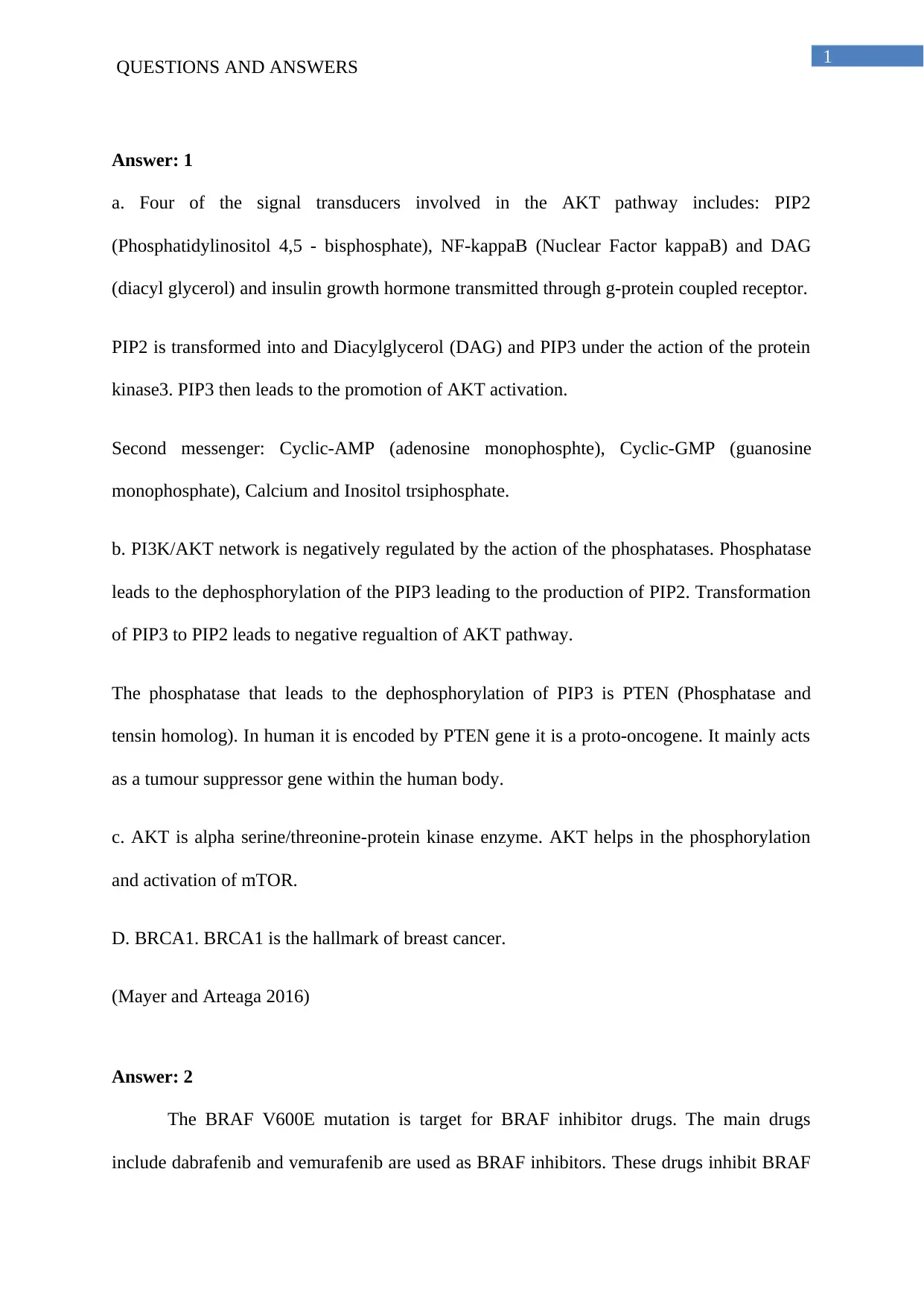
1
QUESTIONS AND ANSWERS
Answer: 1
a. Four of the signal transducers involved in the AKT pathway includes: PIP2
(Phosphatidylinositol 4,5 - bisphosphate), NF-kappaB (Nuclear Factor kappaB) and DAG
(diacyl glycerol) and insulin growth hormone transmitted through g-protein coupled receptor.
PIP2 is transformed into and Diacylglycerol (DAG) and PIP3 under the action of the protein
kinase3. PIP3 then leads to the promotion of AKT activation.
Second messenger: Cyclic-AMP (adenosine monophosphte), Cyclic-GMP (guanosine
monophosphate), Calcium and Inositol trsiphosphate.
b. PI3K/AKT network is negatively regulated by the action of the phosphatases. Phosphatase
leads to the dephosphorylation of the PIP3 leading to the production of PIP2. Transformation
of PIP3 to PIP2 leads to negative regualtion of AKT pathway.
The phosphatase that leads to the dephosphorylation of PIP3 is PTEN (Phosphatase and
tensin homolog). In human it is encoded by PTEN gene it is a proto-oncogene. It mainly acts
as a tumour suppressor gene within the human body.
c. AKT is alpha serine/threonine-protein kinase enzyme. AKT helps in the phosphorylation
and activation of mTOR.
D. BRCA1. BRCA1 is the hallmark of breast cancer.
(Mayer and Arteaga 2016)
Answer: 2
The BRAF V600E mutation is target for BRAF inhibitor drugs. The main drugs
include dabrafenib and vemurafenib are used as BRAF inhibitors. These drugs inhibit BRAF
QUESTIONS AND ANSWERS
Answer: 1
a. Four of the signal transducers involved in the AKT pathway includes: PIP2
(Phosphatidylinositol 4,5 - bisphosphate), NF-kappaB (Nuclear Factor kappaB) and DAG
(diacyl glycerol) and insulin growth hormone transmitted through g-protein coupled receptor.
PIP2 is transformed into and Diacylglycerol (DAG) and PIP3 under the action of the protein
kinase3. PIP3 then leads to the promotion of AKT activation.
Second messenger: Cyclic-AMP (adenosine monophosphte), Cyclic-GMP (guanosine
monophosphate), Calcium and Inositol trsiphosphate.
b. PI3K/AKT network is negatively regulated by the action of the phosphatases. Phosphatase
leads to the dephosphorylation of the PIP3 leading to the production of PIP2. Transformation
of PIP3 to PIP2 leads to negative regualtion of AKT pathway.
The phosphatase that leads to the dephosphorylation of PIP3 is PTEN (Phosphatase and
tensin homolog). In human it is encoded by PTEN gene it is a proto-oncogene. It mainly acts
as a tumour suppressor gene within the human body.
c. AKT is alpha serine/threonine-protein kinase enzyme. AKT helps in the phosphorylation
and activation of mTOR.
D. BRCA1. BRCA1 is the hallmark of breast cancer.
(Mayer and Arteaga 2016)
Answer: 2
The BRAF V600E mutation is target for BRAF inhibitor drugs. The main drugs
include dabrafenib and vemurafenib are used as BRAF inhibitors. These drugs inhibit BRAF
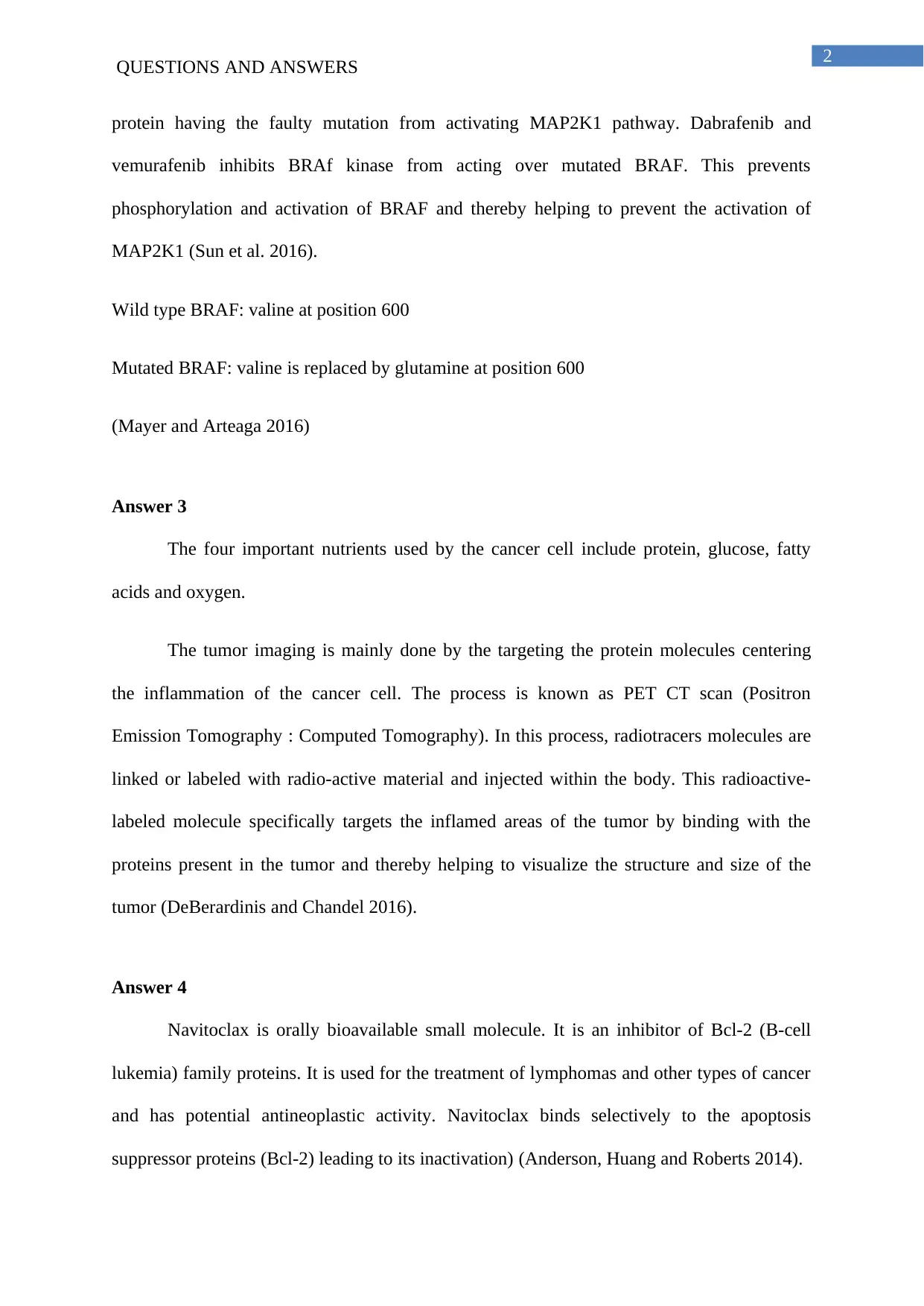
2
QUESTIONS AND ANSWERS
protein having the faulty mutation from activating MAP2K1 pathway. Dabrafenib and
vemurafenib inhibits BRAf kinase from acting over mutated BRAF. This prevents
phosphorylation and activation of BRAF and thereby helping to prevent the activation of
MAP2K1 (Sun et al. 2016).
Wild type BRAF: valine at position 600
Mutated BRAF: valine is replaced by glutamine at position 600
(Mayer and Arteaga 2016)
Answer 3
The four important nutrients used by the cancer cell include protein, glucose, fatty
acids and oxygen.
The tumor imaging is mainly done by the targeting the protein molecules centering
the inflammation of the cancer cell. The process is known as PET CT scan (Positron
Emission Tomography : Computed Tomography). In this process, radiotracers molecules are
linked or labeled with radio-active material and injected within the body. This radioactive-
labeled molecule specifically targets the inflamed areas of the tumor by binding with the
proteins present in the tumor and thereby helping to visualize the structure and size of the
tumor (DeBerardinis and Chandel 2016).
Answer 4
Navitoclax is orally bioavailable small molecule. It is an inhibitor of Bcl-2 (B-cell
lukemia) family proteins. It is used for the treatment of lymphomas and other types of cancer
and has potential antineoplastic activity. Navitoclax binds selectively to the apoptosis
suppressor proteins (Bcl-2) leading to its inactivation) (Anderson, Huang and Roberts 2014).
QUESTIONS AND ANSWERS
protein having the faulty mutation from activating MAP2K1 pathway. Dabrafenib and
vemurafenib inhibits BRAf kinase from acting over mutated BRAF. This prevents
phosphorylation and activation of BRAF and thereby helping to prevent the activation of
MAP2K1 (Sun et al. 2016).
Wild type BRAF: valine at position 600
Mutated BRAF: valine is replaced by glutamine at position 600
(Mayer and Arteaga 2016)
Answer 3
The four important nutrients used by the cancer cell include protein, glucose, fatty
acids and oxygen.
The tumor imaging is mainly done by the targeting the protein molecules centering
the inflammation of the cancer cell. The process is known as PET CT scan (Positron
Emission Tomography : Computed Tomography). In this process, radiotracers molecules are
linked or labeled with radio-active material and injected within the body. This radioactive-
labeled molecule specifically targets the inflamed areas of the tumor by binding with the
proteins present in the tumor and thereby helping to visualize the structure and size of the
tumor (DeBerardinis and Chandel 2016).
Answer 4
Navitoclax is orally bioavailable small molecule. It is an inhibitor of Bcl-2 (B-cell
lukemia) family proteins. It is used for the treatment of lymphomas and other types of cancer
and has potential antineoplastic activity. Navitoclax binds selectively to the apoptosis
suppressor proteins (Bcl-2) leading to its inactivation) (Anderson, Huang and Roberts 2014).
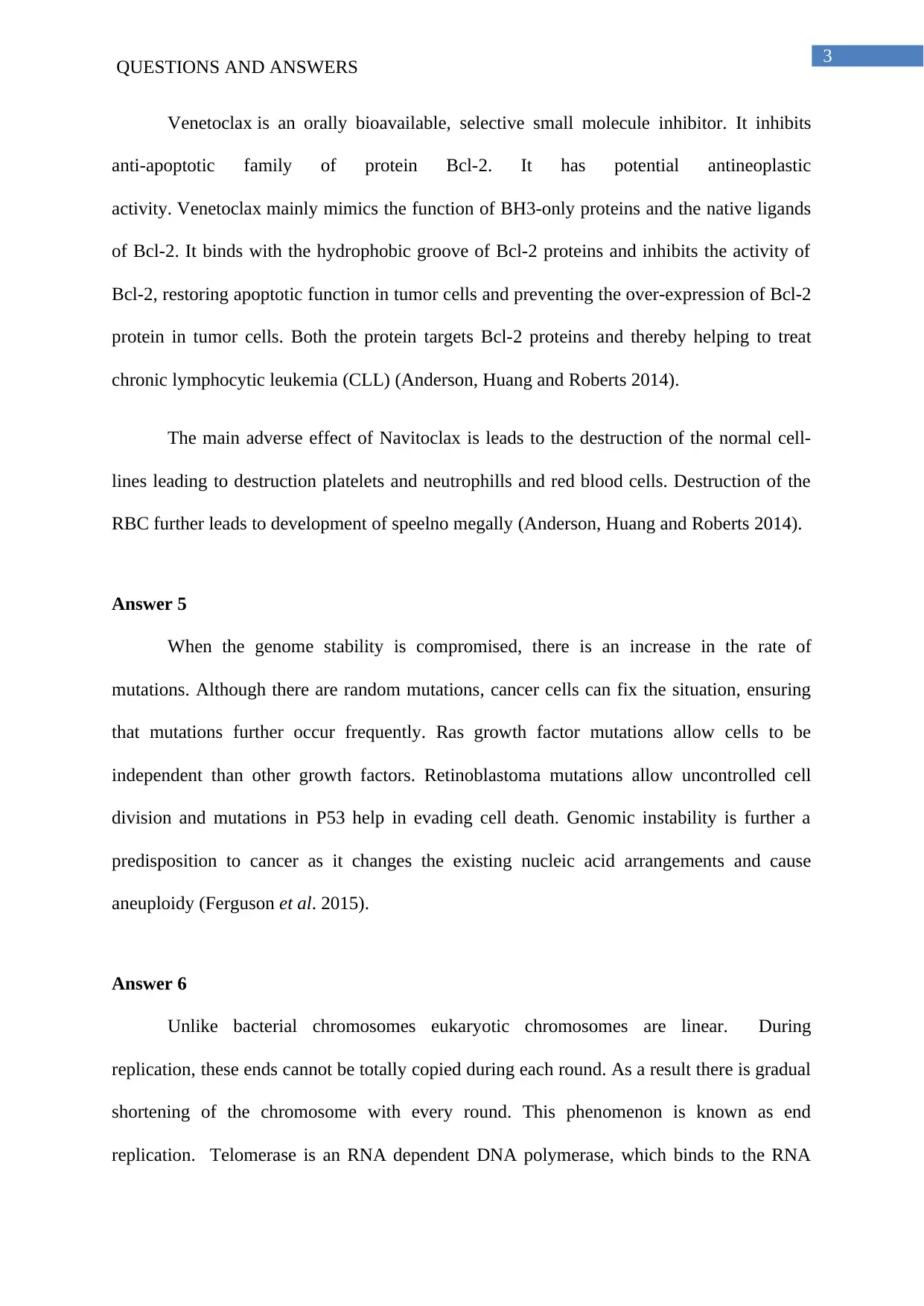
3
QUESTIONS AND ANSWERS
Venetoclax is an orally bioavailable, selective small molecule inhibitor. It inhibits
anti-apoptotic family of protein Bcl-2. It has potential antineoplastic
activity. Venetoclax mainly mimics the function of BH3-only proteins and the native ligands
of Bcl-2. It binds with the hydrophobic groove of Bcl-2 proteins and inhibits the activity of
Bcl-2, restoring apoptotic function in tumor cells and preventing the over-expression of Bcl-2
protein in tumor cells. Both the protein targets Bcl-2 proteins and thereby helping to treat
chronic lymphocytic leukemia (CLL) (Anderson, Huang and Roberts 2014).
The main adverse effect of Navitoclax is leads to the destruction of the normal cell-
lines leading to destruction platelets and neutrophills and red blood cells. Destruction of the
RBC further leads to development of speelno megally (Anderson, Huang and Roberts 2014).
Answer 5
When the genome stability is compromised, there is an increase in the rate of
mutations. Although there are random mutations, cancer cells can fix the situation, ensuring
that mutations further occur frequently. Ras growth factor mutations allow cells to be
independent than other growth factors. Retinoblastoma mutations allow uncontrolled cell
division and mutations in P53 help in evading cell death. Genomic instability is further a
predisposition to cancer as it changes the existing nucleic acid arrangements and cause
aneuploidy (Ferguson et al. 2015).
Answer 6
Unlike bacterial chromosomes eukaryotic chromosomes are linear. During
replication, these ends cannot be totally copied during each round. As a result there is gradual
shortening of the chromosome with every round. This phenomenon is known as end
replication. Telomerase is an RNA dependent DNA polymerase, which binds to the RNA
QUESTIONS AND ANSWERS
Venetoclax is an orally bioavailable, selective small molecule inhibitor. It inhibits
anti-apoptotic family of protein Bcl-2. It has potential antineoplastic
activity. Venetoclax mainly mimics the function of BH3-only proteins and the native ligands
of Bcl-2. It binds with the hydrophobic groove of Bcl-2 proteins and inhibits the activity of
Bcl-2, restoring apoptotic function in tumor cells and preventing the over-expression of Bcl-2
protein in tumor cells. Both the protein targets Bcl-2 proteins and thereby helping to treat
chronic lymphocytic leukemia (CLL) (Anderson, Huang and Roberts 2014).
The main adverse effect of Navitoclax is leads to the destruction of the normal cell-
lines leading to destruction platelets and neutrophills and red blood cells. Destruction of the
RBC further leads to development of speelno megally (Anderson, Huang and Roberts 2014).
Answer 5
When the genome stability is compromised, there is an increase in the rate of
mutations. Although there are random mutations, cancer cells can fix the situation, ensuring
that mutations further occur frequently. Ras growth factor mutations allow cells to be
independent than other growth factors. Retinoblastoma mutations allow uncontrolled cell
division and mutations in P53 help in evading cell death. Genomic instability is further a
predisposition to cancer as it changes the existing nucleic acid arrangements and cause
aneuploidy (Ferguson et al. 2015).
Answer 6
Unlike bacterial chromosomes eukaryotic chromosomes are linear. During
replication, these ends cannot be totally copied during each round. As a result there is gradual
shortening of the chromosome with every round. This phenomenon is known as end
replication. Telomerase is an RNA dependent DNA polymerase, which binds to the RNA
Secure Best Marks with AI Grader
Need help grading? Try our AI Grader for instant feedback on your assignments.
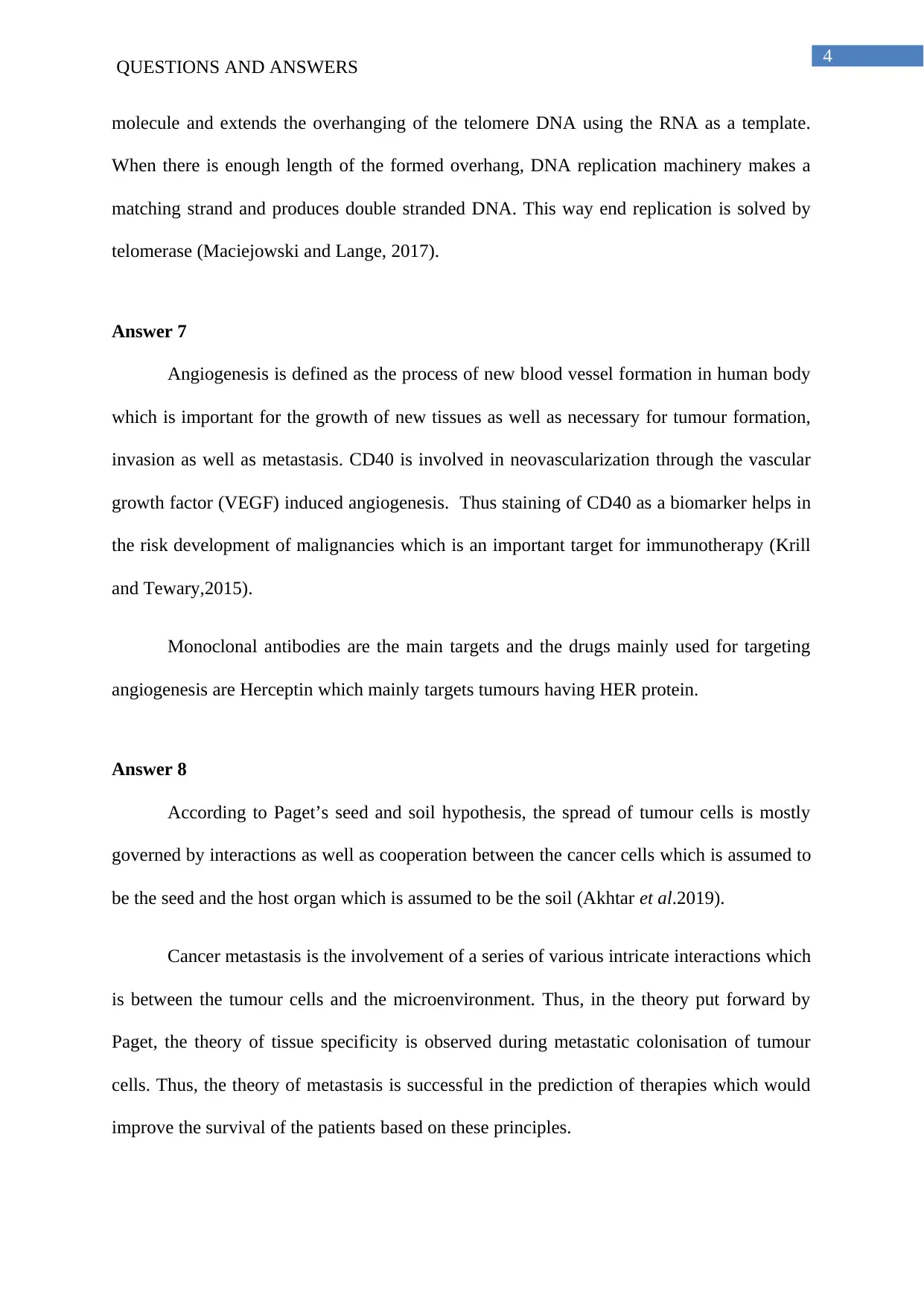
4
QUESTIONS AND ANSWERS
molecule and extends the overhanging of the telomere DNA using the RNA as a template.
When there is enough length of the formed overhang, DNA replication machinery makes a
matching strand and produces double stranded DNA. This way end replication is solved by
telomerase (Maciejowski and Lange, 2017).
Answer 7
Angiogenesis is defined as the process of new blood vessel formation in human body
which is important for the growth of new tissues as well as necessary for tumour formation,
invasion as well as metastasis. CD40 is involved in neovascularization through the vascular
growth factor (VEGF) induced angiogenesis. Thus staining of CD40 as a biomarker helps in
the risk development of malignancies which is an important target for immunotherapy (Krill
and Tewary,2015).
Monoclonal antibodies are the main targets and the drugs mainly used for targeting
angiogenesis are Herceptin which mainly targets tumours having HER protein.
Answer 8
According to Paget’s seed and soil hypothesis, the spread of tumour cells is mostly
governed by interactions as well as cooperation between the cancer cells which is assumed to
be the seed and the host organ which is assumed to be the soil (Akhtar et al.2019).
Cancer metastasis is the involvement of a series of various intricate interactions which
is between the tumour cells and the microenvironment. Thus, in the theory put forward by
Paget, the theory of tissue specificity is observed during metastatic colonisation of tumour
cells. Thus, the theory of metastasis is successful in the prediction of therapies which would
improve the survival of the patients based on these principles.
QUESTIONS AND ANSWERS
molecule and extends the overhanging of the telomere DNA using the RNA as a template.
When there is enough length of the formed overhang, DNA replication machinery makes a
matching strand and produces double stranded DNA. This way end replication is solved by
telomerase (Maciejowski and Lange, 2017).
Answer 7
Angiogenesis is defined as the process of new blood vessel formation in human body
which is important for the growth of new tissues as well as necessary for tumour formation,
invasion as well as metastasis. CD40 is involved in neovascularization through the vascular
growth factor (VEGF) induced angiogenesis. Thus staining of CD40 as a biomarker helps in
the risk development of malignancies which is an important target for immunotherapy (Krill
and Tewary,2015).
Monoclonal antibodies are the main targets and the drugs mainly used for targeting
angiogenesis are Herceptin which mainly targets tumours having HER protein.
Answer 8
According to Paget’s seed and soil hypothesis, the spread of tumour cells is mostly
governed by interactions as well as cooperation between the cancer cells which is assumed to
be the seed and the host organ which is assumed to be the soil (Akhtar et al.2019).
Cancer metastasis is the involvement of a series of various intricate interactions which
is between the tumour cells and the microenvironment. Thus, in the theory put forward by
Paget, the theory of tissue specificity is observed during metastatic colonisation of tumour
cells. Thus, the theory of metastasis is successful in the prediction of therapies which would
improve the survival of the patients based on these principles.
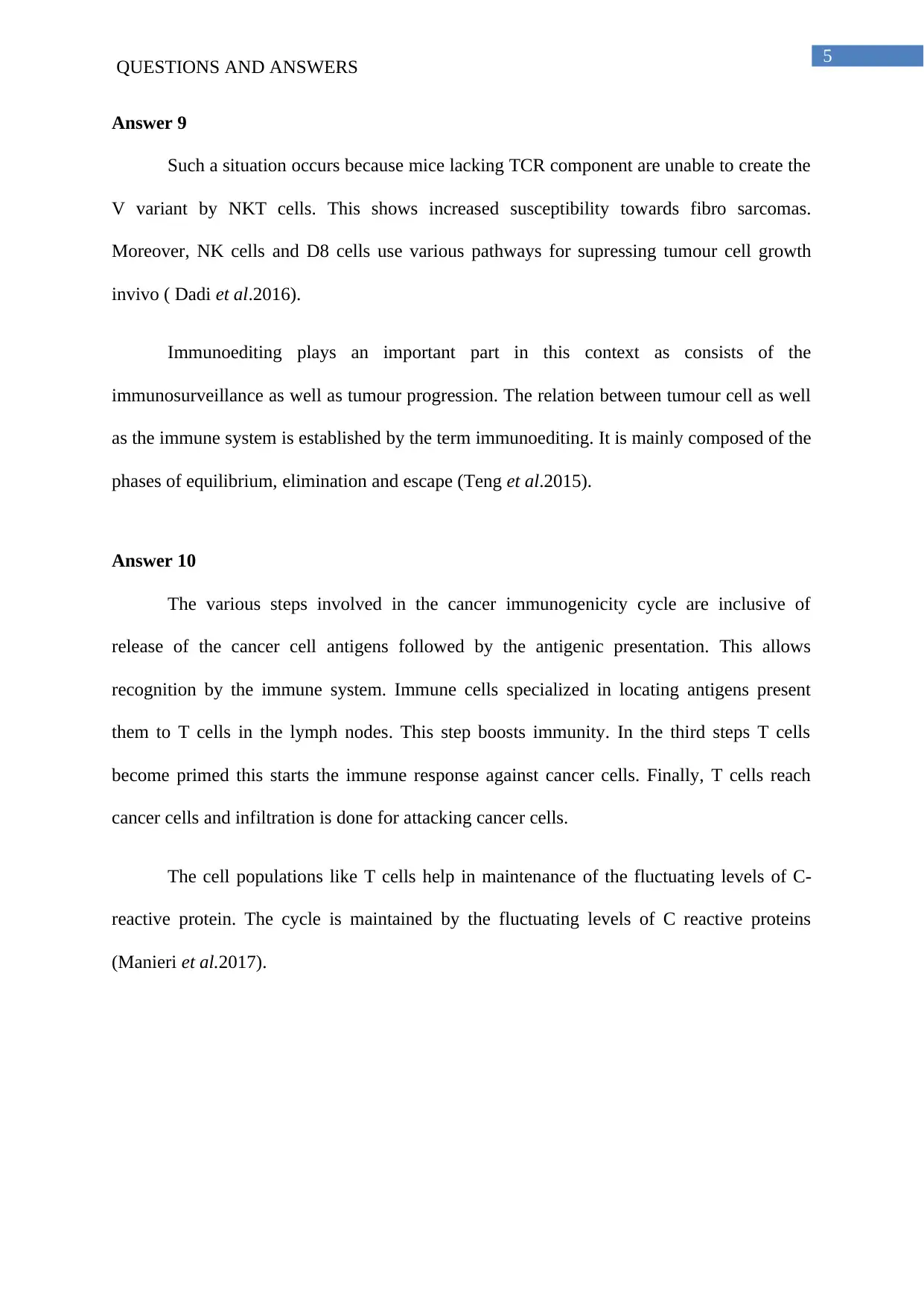
5
QUESTIONS AND ANSWERS
Answer 9
Such a situation occurs because mice lacking TCR component are unable to create the
V variant by NKT cells. This shows increased susceptibility towards fibro sarcomas.
Moreover, NK cells and D8 cells use various pathways for supressing tumour cell growth
invivo ( Dadi et al.2016).
Immunoediting plays an important part in this context as consists of the
immunosurveillance as well as tumour progression. The relation between tumour cell as well
as the immune system is established by the term immunoediting. It is mainly composed of the
phases of equilibrium, elimination and escape (Teng et al.2015).
Answer 10
The various steps involved in the cancer immunogenicity cycle are inclusive of
release of the cancer cell antigens followed by the antigenic presentation. This allows
recognition by the immune system. Immune cells specialized in locating antigens present
them to T cells in the lymph nodes. This step boosts immunity. In the third steps T cells
become primed this starts the immune response against cancer cells. Finally, T cells reach
cancer cells and infiltration is done for attacking cancer cells.
The cell populations like T cells help in maintenance of the fluctuating levels of C-
reactive protein. The cycle is maintained by the fluctuating levels of C reactive proteins
(Manieri et al.2017).
QUESTIONS AND ANSWERS
Answer 9
Such a situation occurs because mice lacking TCR component are unable to create the
V variant by NKT cells. This shows increased susceptibility towards fibro sarcomas.
Moreover, NK cells and D8 cells use various pathways for supressing tumour cell growth
invivo ( Dadi et al.2016).
Immunoediting plays an important part in this context as consists of the
immunosurveillance as well as tumour progression. The relation between tumour cell as well
as the immune system is established by the term immunoediting. It is mainly composed of the
phases of equilibrium, elimination and escape (Teng et al.2015).
Answer 10
The various steps involved in the cancer immunogenicity cycle are inclusive of
release of the cancer cell antigens followed by the antigenic presentation. This allows
recognition by the immune system. Immune cells specialized in locating antigens present
them to T cells in the lymph nodes. This step boosts immunity. In the third steps T cells
become primed this starts the immune response against cancer cells. Finally, T cells reach
cancer cells and infiltration is done for attacking cancer cells.
The cell populations like T cells help in maintenance of the fluctuating levels of C-
reactive protein. The cycle is maintained by the fluctuating levels of C reactive proteins
(Manieri et al.2017).
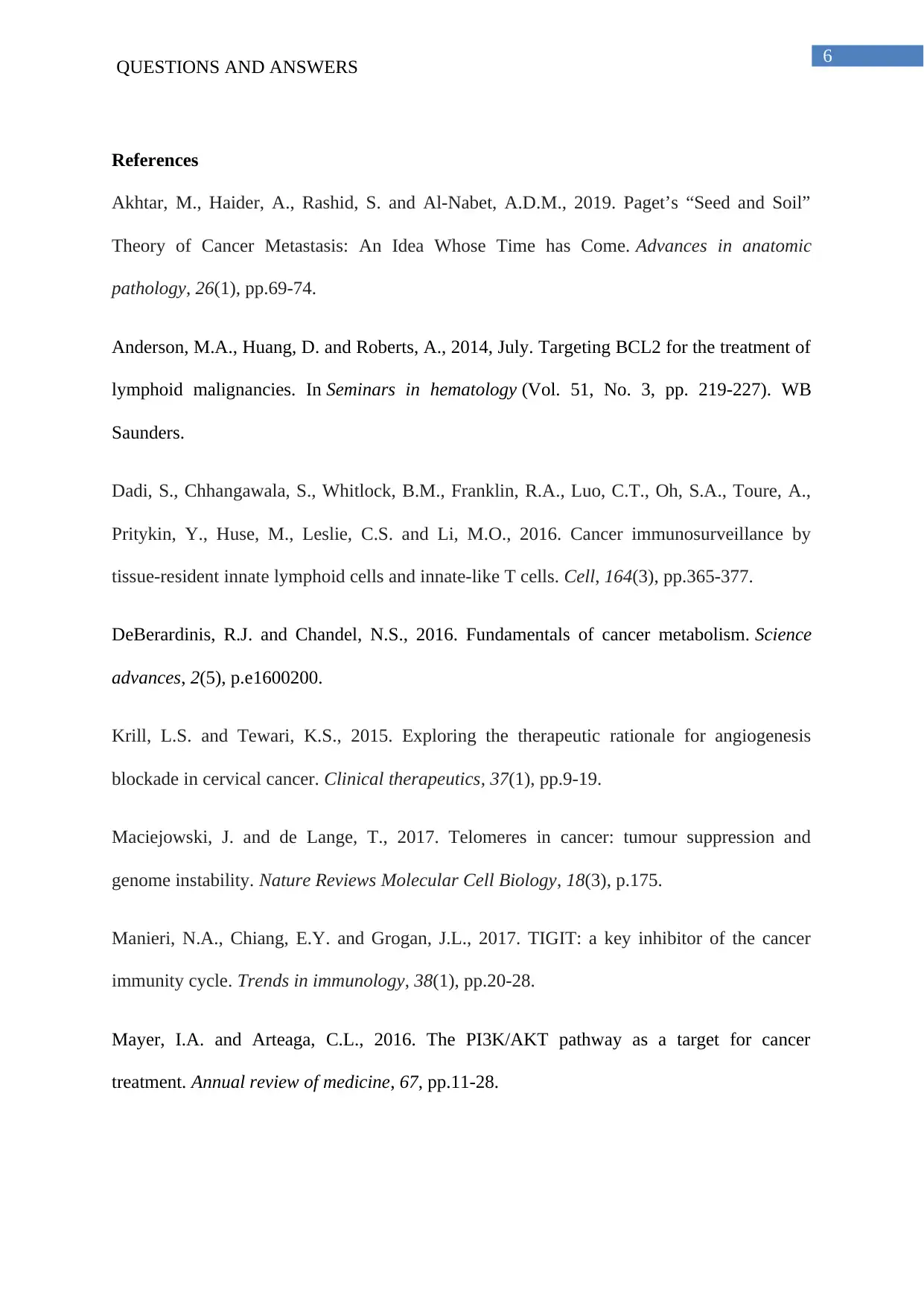
6
QUESTIONS AND ANSWERS
References
Akhtar, M., Haider, A., Rashid, S. and Al-Nabet, A.D.M., 2019. Paget’s “Seed and Soil”
Theory of Cancer Metastasis: An Idea Whose Time has Come. Advances in anatomic
pathology, 26(1), pp.69-74.
Anderson, M.A., Huang, D. and Roberts, A., 2014, July. Targeting BCL2 for the treatment of
lymphoid malignancies. In Seminars in hematology (Vol. 51, No. 3, pp. 219-227). WB
Saunders.
Dadi, S., Chhangawala, S., Whitlock, B.M., Franklin, R.A., Luo, C.T., Oh, S.A., Toure, A.,
Pritykin, Y., Huse, M., Leslie, C.S. and Li, M.O., 2016. Cancer immunosurveillance by
tissue-resident innate lymphoid cells and innate-like T cells. Cell, 164(3), pp.365-377.
DeBerardinis, R.J. and Chandel, N.S., 2016. Fundamentals of cancer metabolism. Science
advances, 2(5), p.e1600200.
Krill, L.S. and Tewari, K.S., 2015. Exploring the therapeutic rationale for angiogenesis
blockade in cervical cancer. Clinical therapeutics, 37(1), pp.9-19.
Maciejowski, J. and de Lange, T., 2017. Telomeres in cancer: tumour suppression and
genome instability. Nature Reviews Molecular Cell Biology, 18(3), p.175.
Manieri, N.A., Chiang, E.Y. and Grogan, J.L., 2017. TIGIT: a key inhibitor of the cancer
immunity cycle. Trends in immunology, 38(1), pp.20-28.
Mayer, I.A. and Arteaga, C.L., 2016. The PI3K/AKT pathway as a target for cancer
treatment. Annual review of medicine, 67, pp.11-28.
QUESTIONS AND ANSWERS
References
Akhtar, M., Haider, A., Rashid, S. and Al-Nabet, A.D.M., 2019. Paget’s “Seed and Soil”
Theory of Cancer Metastasis: An Idea Whose Time has Come. Advances in anatomic
pathology, 26(1), pp.69-74.
Anderson, M.A., Huang, D. and Roberts, A., 2014, July. Targeting BCL2 for the treatment of
lymphoid malignancies. In Seminars in hematology (Vol. 51, No. 3, pp. 219-227). WB
Saunders.
Dadi, S., Chhangawala, S., Whitlock, B.M., Franklin, R.A., Luo, C.T., Oh, S.A., Toure, A.,
Pritykin, Y., Huse, M., Leslie, C.S. and Li, M.O., 2016. Cancer immunosurveillance by
tissue-resident innate lymphoid cells and innate-like T cells. Cell, 164(3), pp.365-377.
DeBerardinis, R.J. and Chandel, N.S., 2016. Fundamentals of cancer metabolism. Science
advances, 2(5), p.e1600200.
Krill, L.S. and Tewari, K.S., 2015. Exploring the therapeutic rationale for angiogenesis
blockade in cervical cancer. Clinical therapeutics, 37(1), pp.9-19.
Maciejowski, J. and de Lange, T., 2017. Telomeres in cancer: tumour suppression and
genome instability. Nature Reviews Molecular Cell Biology, 18(3), p.175.
Manieri, N.A., Chiang, E.Y. and Grogan, J.L., 2017. TIGIT: a key inhibitor of the cancer
immunity cycle. Trends in immunology, 38(1), pp.20-28.
Mayer, I.A. and Arteaga, C.L., 2016. The PI3K/AKT pathway as a target for cancer
treatment. Annual review of medicine, 67, pp.11-28.
Paraphrase This Document
Need a fresh take? Get an instant paraphrase of this document with our AI Paraphraser

7
QUESTIONS AND ANSWERS
Sun, C., Wang, L., Huang, S., Heynen, G.J., Prahallad, A., Robert, C., Haanen, J., Blank, C.,
Wesseling, J., Willems, S.M. and Zecchin, D., 2014. Reversible and adaptive resistance to
BRAF (V600E) inhibition in melanoma. Nature, 508(7494), p.118.
Teng, M.W., Galon, J., Fridman, W.H. and Smyth, M.J., 2015. From mice to humans:
developments in cancer immunoediting. The Journal of clinical investigation, 125(9),
pp.3338-3346.
QUESTIONS AND ANSWERS
Sun, C., Wang, L., Huang, S., Heynen, G.J., Prahallad, A., Robert, C., Haanen, J., Blank, C.,
Wesseling, J., Willems, S.M. and Zecchin, D., 2014. Reversible and adaptive resistance to
BRAF (V600E) inhibition in melanoma. Nature, 508(7494), p.118.
Teng, M.W., Galon, J., Fridman, W.H. and Smyth, M.J., 2015. From mice to humans:
developments in cancer immunoediting. The Journal of clinical investigation, 125(9),
pp.3338-3346.
1 out of 8
Your All-in-One AI-Powered Toolkit for Academic Success.
+13062052269
info@desklib.com
Available 24*7 on WhatsApp / Email
![[object Object]](/_next/static/media/star-bottom.7253800d.svg)
Unlock your academic potential
© 2024 | Zucol Services PVT LTD | All rights reserved.